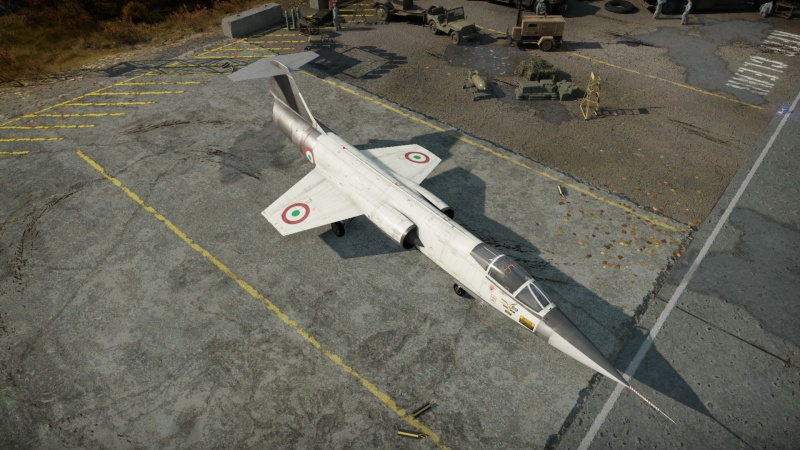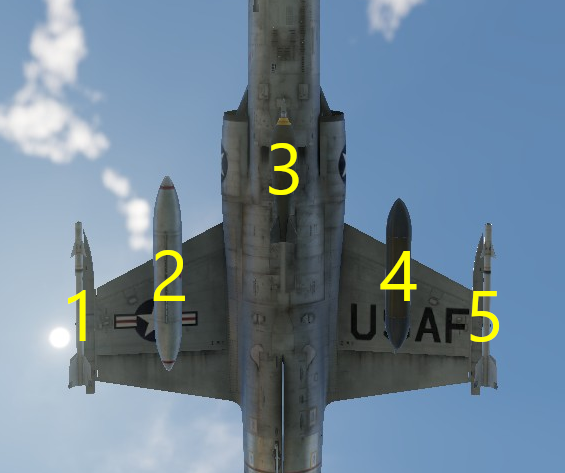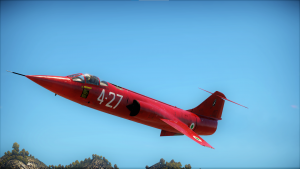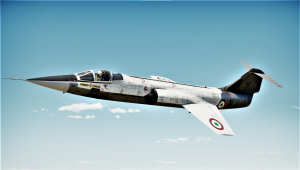Difference between revisions of "F-104G (Italy)"
Colok76286 (talk | contribs) (Edits) |
(→Details) |
||
| (2 intermediate revisions by 2 users not shown) | |||
| Line 55: | Line 55: | ||
! Combat !! Take-off !! Landing !! + !! - | ! Combat !! Take-off !! Landing !! + !! - | ||
|- | |- | ||
| − | | 1, | + | | 1,555 <!-- {{Specs|destruction|body}} --> || {{Specs|destruction|gear}} || N/A || 827 || 444 || ~12 || ~5 |
|- | |- | ||
|} | |} | ||
| Line 182: | Line 182: | ||
{{Navigation-Start|Default weapon presets}} | {{Navigation-Start|Default weapon presets}} | ||
{{Navigation-First-Simple-Line}} | {{Navigation-First-Simple-Line}} | ||
| + | |||
* Without load | * Without load | ||
* 2 x AIM-9B Sidewinder missiles | * 2 x AIM-9B Sidewinder missiles | ||
| Line 203: | Line 204: | ||
Recommended payloads: | Recommended payloads: | ||
| − | * | + | * 2 x AIM-9J for air battles |
| − | * | + | * 1 x 2,000 lb, 2 x 1,000 lb, AIM-9J for mixed battles to shoot down planes and destroy tanks with the bombs. |
'''Air RB:''' | '''Air RB:''' | ||
| Line 231: | Line 232: | ||
'''Cons:''' | '''Cons:''' | ||
| − | * Insanely poor manoeuvrability | + | * Insanely poor manoeuvrability at almost any speed |
| − | * Compared to other F-104G variants, it's only capable of equipping | + | * Compared to other F-104G variants, it's only capable of equipping 2 air-to-air missiles |
* Large turning radius due to small wing surface and high speed | * Large turning radius due to small wing surface and high speed | ||
* High takeoff and landing speeds | * High takeoff and landing speeds | ||
| Line 241: | Line 242: | ||
The story of the Italian F-104G originally began in America. In February of 1954 at the Lockheed facilities in America, the first 2 prototypes of the F-104 would take flight for the first time. America was looking to develop a new aircraft to combat the Soviet's new age of supersonic jet fighters. The aircraft would incorporate the smallest possible airframe with the most technologically advanced turbojet at the time, to create the base of what would become the F-104. Although the program would have some minor setbacks, such as the intended engine not being available during the beginning, development would continue and would lead to the first variant of the F-104, the F-104A. From the base variant of the F-104 many variants would begin to be developed, such as the F-104C, the F-104S and in this case, the F-104G. | The story of the Italian F-104G originally began in America. In February of 1954 at the Lockheed facilities in America, the first 2 prototypes of the F-104 would take flight for the first time. America was looking to develop a new aircraft to combat the Soviet's new age of supersonic jet fighters. The aircraft would incorporate the smallest possible airframe with the most technologically advanced turbojet at the time, to create the base of what would become the F-104. Although the program would have some minor setbacks, such as the intended engine not being available during the beginning, development would continue and would lead to the first variant of the F-104, the F-104A. From the base variant of the F-104 many variants would begin to be developed, such as the F-104C, the F-104S and in this case, the F-104G. | ||
| − | [[File:F-104G MM.6546 Ferrari .png|thumb| | + | [[File:F-104G MM.6546 Ferrari .png|thumb|F-104G (MM.6546) for the Ferrari competition]] |
The main differences of the G variant compared to the others would be a reinforced airframe, larger vertical stabilizer, updated turbofans, and improved electronics. Due to these changes, the F-104G would be known as the "definitive" variant of the Starfighter. The G would first take flight on October of 1960, it would initially be built for the German Luftwaffe as at the time they were looking for a fast aircraft which would be able to deliver nuclear payloads, however that didn't stop it from generating enough interest to be exported and licence-produced in many countries, such as in Italy. The aircraft's licensing was handled by multiple manufacturers, notably Messerschmitt-Bölkow-Blohm (MBB), FIAT Aviazione, Fokker, and Sociétés Anonyme Belge de Constructions Aéronautiques (SABCA). | The main differences of the G variant compared to the others would be a reinforced airframe, larger vertical stabilizer, updated turbofans, and improved electronics. Due to these changes, the F-104G would be known as the "definitive" variant of the Starfighter. The G would first take flight on October of 1960, it would initially be built for the German Luftwaffe as at the time they were looking for a fast aircraft which would be able to deliver nuclear payloads, however that didn't stop it from generating enough interest to be exported and licence-produced in many countries, such as in Italy. The aircraft's licensing was handled by multiple manufacturers, notably Messerschmitt-Bölkow-Blohm (MBB), FIAT Aviazione, Fokker, and Sociétés Anonyme Belge de Constructions Aéronautiques (SABCA). | ||
| − | [[File:F-104G 4°Stormo.png|thumb| | + | [[File:F-104G 4°Stormo.png|thumb|F-104G of the 4°Stormo]] |
The first aircraft (MM 6501) was delivered to Italy on March 3rd of 1961. It was built by Lockheed, however after being transferred to Italy it was dismantled and used as a model for the construction under license of the 105 units ordered by the Italian Air Force. Aeritalia ended up producing a total of 230 Starfighters in different versions, of which 124 would be made for the Italian Air Force. The F-104G in Italian service was mainly used as an all-weather interceptor armed with AIM-9B Sidewinder infrared guided air-to-air missiles. Other departments instead used the F-104G as a conventional or strike fighter-bomber. The F-104G would eventually be replaced in these roles by the "Tornado IDS", the F-104Gs were concentrated at the 3rd Aerobrigata (later 3rd Stormo) which already used the RF-104G reconnaissance variant. A unit of F/RF-104G of the 3rd Wing took part in the 1991 Gulf War, operating from the Turkish base of Incirlik. Most of the F-104G's would be turned into static displays or kept in museums, for example one resides in Vigna di Valle Airforce museum, this one was the first entirely Italian-built F-104G which first flew on the 5th October of 1962. | The first aircraft (MM 6501) was delivered to Italy on March 3rd of 1961. It was built by Lockheed, however after being transferred to Italy it was dismantled and used as a model for the construction under license of the 105 units ordered by the Italian Air Force. Aeritalia ended up producing a total of 230 Starfighters in different versions, of which 124 would be made for the Italian Air Force. The F-104G in Italian service was mainly used as an all-weather interceptor armed with AIM-9B Sidewinder infrared guided air-to-air missiles. Other departments instead used the F-104G as a conventional or strike fighter-bomber. The F-104G would eventually be replaced in these roles by the "Tornado IDS", the F-104Gs were concentrated at the 3rd Aerobrigata (later 3rd Stormo) which already used the RF-104G reconnaissance variant. A unit of F/RF-104G of the 3rd Wing took part in the 1991 Gulf War, operating from the Turkish base of Incirlik. Most of the F-104G's would be turned into static displays or kept in museums, for example one resides in Vigna di Valle Airforce museum, this one was the first entirely Italian-built F-104G which first flew on the 5th October of 1962. | ||
Latest revision as of 05:11, 23 May 2024
Contents
Description
The first F-104G to be delivered to Italy was on March 3, 1961, built by Lockheed and was later disassembled and studied for production in Italy. 105 units were then produced under license in Italy, and they were used as interceptor aircraft, armed with AIM-9B Sidewinder missiles, and in some departments were used as fighter-bombers. After the continued use of the F-104G, an updated version was requested that would become the F-104S produced by Aeritalia. At the end of their service, the various Italian F-104s would become monuments and kept in museums.
Introduced in Update "Direct Hit", the F-104G is not very manoeuvrable but in return has great acceleration and speed so should be used more as a boom-and-zoom fighter with the 20 mm cannon and the AIM-9J missiles. Thanks to its acceleration, you can quickly climb to high altitudes or chase enemy aircraft, but never turn-fight because it will rarely find success. For the defence of the aircraft you can count on the Chaff and Flares to avoid IR and semi-active radar missiles.
General info
Flight performance
| Characteristics | Max Speed (km/h at 15,240 m) |
Max altitude (metres) |
Turn time (seconds) |
Rate of climb (metres/second) |
Take-off run (metres) | |||
|---|---|---|---|---|---|---|---|---|
| AB | RB | AB | RB | AB | RB | |||
| Stock | 2,341 | 2,315 | 16000 | 34.5 | 35.1 | 230.3 | 222.2 | 850 |
| Upgraded | 2,433 | 2,387 | 33.5 | 34.0 | 292.1 | 260.0 | ||
Details
| Features | |||||
|---|---|---|---|---|---|
| Combat flaps | Take-off flaps | Landing flaps | Air brakes | Arrestor gear | Drogue chute |
| X | ✓ | ✓ | ✓ | ✓ | ✓ |
| Limits | ||||||
|---|---|---|---|---|---|---|
| Wings (km/h) | Gear (km/h) | Flaps (km/h) | Max Static G | |||
| Combat | Take-off | Landing | + | - | ||
| 1,555 | 546 | N/A | 827 | 444 | ~12 | ~5 |
| Optimal velocities (km/h) | |||
|---|---|---|---|
| Ailerons | Rudder | Elevators | Radiator |
| < 720 | < 950 | < 800 | N/A |
Engine performance
| Engine | Aircraft mass | ||||||
|---|---|---|---|---|---|---|---|
| Engine name | Number | Basic mass | Wing loading (full fuel) | ||||
| General Electric J79-GE-11 | 1 | 6,552 kg | 532 kg/m2 | ||||
| Engine characteristics | Mass with fuel (no weapons load) | Max Takeoff Weight | |||||
| Weight (each) | Type | 10m fuel | 20m fuel | 30m fuel | 35m fuel | ||
| 1,615 kg | Afterburning axial-flow turbojet | 7,344 kg | 8,057 kg | 8,809 kg | 9,194 kg | 24,000 kg | |
| Maximum engine thrust @ 0 m (RB/SB) | Thrust to weight ratio @ 0 m (WEP) | ||||||
| Condition | 100% | WEP | 10m fuel | 20m fuel | 30m fuel | 35m fuel | MTOW |
| Stationary | 4,128 kgf | 6,357 kgf | 0.87 | 0.79 | 0.72 | 0.69 | 0.26 |
| Optimal | 4,128 kgf (0 km/h) |
8,391 kgf (1,200 km/h) |
1.14 | 1.04 | 0.95 | 0.91 | 0.35 |
Survivability and armour
The F-104G has no armour; be it in the form of armour plates or armoured glass. Fuel tanks are self-sealing, which is pretty much a standard feature at this rank. The F-104G also has access to countermeasures as a tier I modification (unlike the Chinese F-104G).
Modifications and economy
Armaments
| Ballistic Computer | |||
|---|---|---|---|
| CCIP (Guns) | CCIP (Rockets) | CCIP (Bombs) | CCRP (Bombs) |
| |
|
|
|
Offensive armament
The F-104G (Italy) is armed with:
- A choice between two presets:
- 1 x 20 mm M61A1 cannon, chin-mounted (750 rpg)
- 1 x 20 mm M61A1 cannon + 60 x countermeasures
Suspended armament
The F-104G (Italy) can be outfitted with the following ordnance:
| 1 | 2 | 3 | 4 | 5 | ||
|---|---|---|---|---|---|---|
| 500 lb LDGP Mk 82 bombs | 1 | 1 | 1 | |||
| 500 lb Mk 82 Snakeye bombs | 1 | 1 | 1 | |||
| 750 lb M117 cone 45 bombs | 1 | 1 | 1 | |||
| 1,000 lb LDGP Mk 83 bombs | 1 | 1 | 1 | |||
| 2,000 lb LDGP Mk 84 bombs | 1 | |||||
| BLU-1 incendiary bombs | 1 | 1 | 1 | |||
| FFAR Mighty Mouse rockets | 19 | 19 | ||||
| Zuni Mk32 Mod 0 ATAP rockets | 4 | 4 | ||||
| AIM-9B Sidewinder missiles | 1 | 1 | ||||
| AIM-9J Sidewinder missiles | 1 | 1 | ||||
| Maximum permissible weight imbalance: 500 kg | ||||||
| Default weapon presets | |
|---|---|
| |
Usage in battles
F-104G is a hit-and-run type of airplane, for the simple fact that the wings of this airplane are very small, and this means the aircraft has little manoeuvrability. Its strong point is its engine that makes it very fast and gives it a thrust of 4,530 kgf while with afterburner 6,360 kgf, this makes it capable of regaining speed very quickly after a manoeuvre.
The Italian F-104G, unlike other F-104, carries chaff and flares so players also have the possibility to defend from both IR and Radar missile threats. When using flares, do not continue going straight and instead try to manoeuvre so the missile loses track of the F-104G's engine exhaust and focuses on the flares.
Recommended payloads:
- 2 x AIM-9J for air battles
- 1 x 2,000 lb, 2 x 1,000 lb, AIM-9J for mixed battles to shoot down planes and destroy tanks with the bombs.
Air RB:
As soon as taking off, players can use two tactics with the F-104G. The first tactic is to go head-on at low altitude against enemy jets. The second tactic is to flank around the map and attack the enemy from behind.
Ground RB:
When using the F-104G, remember to stay at lower altitude to avoid enemy anti-aircraft from locking on, then go out and launch the bombs or rockets that was brought into the battle against the enemy. After expending all the payload against the enemy, return to the base and come back for another round of attack runs. If bringing anti-air missiles, the F-104G can also loiter and help maintain air superiority by shooting down enemy aircraft that appear.
Pros and cons
Pros:
- Great top speed and acceleration
- Great rate of climb
- Good roll rate
- Powerful M61 Vulcan cannon with a very high fire rate, great ballistics and high damage
- Wide selection of secondary ordnance; much better than earlier F-104s and excellent for a bombing or ground-attack role
- Has a ballistic computer for every weapon
- Access to two potent AIM-9J sidewinder air-to-air missiles
- Access to 60 chaff/flare countermeasures
- Decent fuel capacity and also boasts a good fuel efficiency and economy even using only the afterburner
Cons:
- Insanely poor manoeuvrability at almost any speed
- Compared to other F-104G variants, it's only capable of equipping 2 air-to-air missiles
- Large turning radius due to small wing surface and high speed
- High takeoff and landing speeds
- Only has 3 pylons for air-to-ground ordnance
History
The story of the Italian F-104G originally began in America. In February of 1954 at the Lockheed facilities in America, the first 2 prototypes of the F-104 would take flight for the first time. America was looking to develop a new aircraft to combat the Soviet's new age of supersonic jet fighters. The aircraft would incorporate the smallest possible airframe with the most technologically advanced turbojet at the time, to create the base of what would become the F-104. Although the program would have some minor setbacks, such as the intended engine not being available during the beginning, development would continue and would lead to the first variant of the F-104, the F-104A. From the base variant of the F-104 many variants would begin to be developed, such as the F-104C, the F-104S and in this case, the F-104G.
The main differences of the G variant compared to the others would be a reinforced airframe, larger vertical stabilizer, updated turbofans, and improved electronics. Due to these changes, the F-104G would be known as the "definitive" variant of the Starfighter. The G would first take flight on October of 1960, it would initially be built for the German Luftwaffe as at the time they were looking for a fast aircraft which would be able to deliver nuclear payloads, however that didn't stop it from generating enough interest to be exported and licence-produced in many countries, such as in Italy. The aircraft's licensing was handled by multiple manufacturers, notably Messerschmitt-Bölkow-Blohm (MBB), FIAT Aviazione, Fokker, and Sociétés Anonyme Belge de Constructions Aéronautiques (SABCA).
The first aircraft (MM 6501) was delivered to Italy on March 3rd of 1961. It was built by Lockheed, however after being transferred to Italy it was dismantled and used as a model for the construction under license of the 105 units ordered by the Italian Air Force. Aeritalia ended up producing a total of 230 Starfighters in different versions, of which 124 would be made for the Italian Air Force. The F-104G in Italian service was mainly used as an all-weather interceptor armed with AIM-9B Sidewinder infrared guided air-to-air missiles. Other departments instead used the F-104G as a conventional or strike fighter-bomber. The F-104G would eventually be replaced in these roles by the "Tornado IDS", the F-104Gs were concentrated at the 3rd Aerobrigata (later 3rd Stormo) which already used the RF-104G reconnaissance variant. A unit of F/RF-104G of the 3rd Wing took part in the 1991 Gulf War, operating from the Turkish base of Incirlik. Most of the F-104G's would be turned into static displays or kept in museums, for example one resides in Vigna di Valle Airforce museum, this one was the first entirely Italian-built F-104G which first flew on the 5th October of 1962.
Media
- Skins
See also
External links
Paste links to sources and external resources, such as:
- topic on the official game forum;
- other literature.
| Fiat Aviation (Fiat Aviazione) | |
|---|---|
| Fighters | CR.32 · CR.32 bis · CR.32 quater |
| CR.42 · Marcolin's C.R.42 CN · ▀Marcolin's C.R.42 CN | |
| G.50 serie 2 · G.50 AS serie 7 | |
| G.55 sottoserie 0 · G.55 serie 1 · G.55S | |
| G.56 | |
| Jet fighters | G.91 pre-serie · G.91 R/1 · G.91 Y · G.91 YS |
| ▄F-86K* | |
| ▄F-104G* · F-104S* · F-104S.ASA* · ▄F-104S TAF* | |
| Strike aircraft | F.C.20 Bis |
| Bombers | B.R.20DR · B.R.20M M1 |
| Export/Captured | J11 · ▀CR.42 |
| ▀G.50 serie 2 · ▀G.50 AS serie 7 | |
| ◄G.91 R/3 · ◄G.91 R/4 · G.91 R/4 | |
| *Licensed | |
| See also | North American Aviation · Lockheed Martin |
| Italy jet aircraft | |
|---|---|
| Aerfer | Sagittario 2 · Ariete |
| Fiat | G.91 pre-serie · G.91 R/1 · G.91 R/4 (Portugal) · G.91 Y · G.91 YS |
| AMX International | AMX · AMX A-1A (Brazil) |
| Panavia | Tornado ADV · ▄Tornado IDS · ▄Tornado IDS (1995) |
| Foreign: | |
| Vampire | Vampire FB 52A |
| F-84 | ▄F-84F · ▄F-84G-21-RE |
| F-86 | CL-13 Mk.4 · ▄F-86K |
| F-104 | ▄F-104G · F-104S · ▄F-104S TAF (Turkey) · F-104S.ASA |
| F-16 | ▄F-16A ADF |
| AV-8 | ▄AV-8B Plus |
| Hungary | |
| Mikoyan-Gurevich | ◔MiG-15bis · ◔MiG-17PF · ◔MiG-21MF · ◔MiG-21bis-SAU · ◔MiG-23MF · ◔MiG-29 |
| Ilyushin | ◔IL-28 |
| Sukhoi | ◔Su-22M3 |
| Saab | ◔JAS39EBS HU C |








